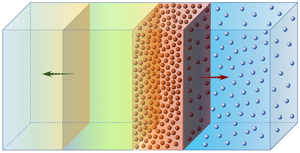Published online by Cambridge University Press: 28 October 2020

A new analytical model is derived based on physical concepts and conservation laws, in order to evaluate the post-shock gas velocity, the gas density and the spray dispersion topology during the interaction of a shock wave and a water spray in a one-dimensional configuration. The model is validated against numerical simulations over a wide range of incident Mach numbers  $M_s$ and particle volume fractions
$M_s$ and particle volume fractions  $\tau _{v,0}$. Two regimes of shock reflection have been identified depending on
$\tau _{v,0}$. Two regimes of shock reflection have been identified depending on  $M_s$, where the reflected pressure expansion propagates either opposite to the incident shock-wave direction for weak incident Mach numbers or along with it for strong Mach numbers. The numerical simulations reveal the presence of a particle number-density peak for
$M_s$, where the reflected pressure expansion propagates either opposite to the incident shock-wave direction for weak incident Mach numbers or along with it for strong Mach numbers. The numerical simulations reveal the presence of a particle number-density peak for  $M_s > 2$ and with particle diameters of the order of
$M_s > 2$ and with particle diameters of the order of  ${O}(10)\ \mathrm {\mu } \textrm {m}$. The formation of the number-density peak is discussed and a necessary condition for its existence is proposed for the first time.
${O}(10)\ \mathrm {\mu } \textrm {m}$. The formation of the number-density peak is discussed and a necessary condition for its existence is proposed for the first time.